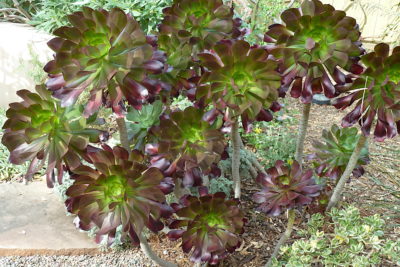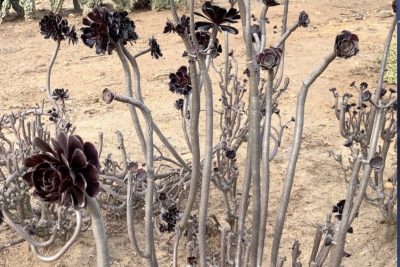Aeoniums are some of the most beautiful and exotic looking plants you can grow in your garden. With their unique rosette shapes and stunning foliage colors they make a dramatic statement in both containers and planted beds. Though aeoniums are native to the Canary Islands, they can be grown successfully outdoors in many regions if given the right conditions. Follow these tips to create a thriving aeonium garden that will have your neighbors green with envy!
Choosing the Right Aeonium Varieties
With over 35 species and countless cultivars, there is an aeonium to fit any garden. Consider the size of the plant and the coloring when selecting varieties. Smaller aeoniums like Aeonium tabuliforme work well in rock gardens and mixed containers, while larger types can be used as specimen plants. Foliage comes in various shades of green, burgundy, bronze, and black. Variegated varieties have striking leaves edged in white, cream, or yellow.
Popular varieties include:
- Aeonium ‘Zwartkop’ – Deep purple almost black foliage. Grows up to 3 ft wide.
- Aeonium arboreum ‘Atropurpureum’ – Dark purple leaves with green centers. Reaches 3 ft tall.
- Aeonium ‘Sunburst’ – Large yellow and green variegated leaves. Grows up to 3 ft wide and 2 ft tall.
- Aeonium haworthii – Tight lime green rosettes on short stems. Stays under 1 ft in height.
- Aeonium ‘Kiwi’ – Light green leaves with unique white variegation. Grows up to 2 ft wide.
Providing the Right Growing Conditions
Aeoniums need specific conditions to thrive in the garden. Here are the keys to success:
Sun Exposure
- Aeoniums require full sun to partial shade. Approximately 4-6 hours of direct sun is ideal.
- Provide some afternoon shade in very hot climates.
Soil
-
Well-draining soil is essential to prevent rot. Incorporate sand or gravel into normal garden soil to improve drainage.
-
Aim for a soil pH between 6 and 7. Aeoniums struggle in very alkaline soils.
Water
-
Allow soil to dry out between waterings. Aeoniums store water in their leaves and are prone to rot if overwatered.
-
Provide extra water during periods of drought. Mature plants can handle some drought but young plants need more consistent moisture.
-
In winter, water only when soil is completely dry. Reduce frequency.
Temperature
-
Aeoniums tolerate temperatures above 30°F. Protect from hard frosts and freezes.
-
Move pots to a protected area or cover in-ground plants if temps dip below freezing.
Planting and Maintaining Healthy Aeoniums
Once you’ve selected the right site and prepared the soil, it’s time for planting:
-
Remove aeoniums from nursery pots, loosen roots, and plant at the same soil level they were growing in the pot.
-
Space plants 1-3 feet apart depending on variety size. Give them room to reach maturity.
-
Water thoroughly after planting and cover surrounding soil with mulch to retain moisture.
-
Stake tall varieties if needed to provide support in windy areas.
Ongoing maintenance:
-
Apply a balanced liquid fertilizer monthly during spring and summer. Avoid high nitrogen formulas.
-
Prune off any damaged leaves or spent flower stalks to keep plants looking tidy.
-
Propagate in early spring by taking 3-5 inch cuttings from healthy stems. Allow to dry briefly before planting.
-
Repot container plants every 2-3 years in spring using cactus mix amended with perlite. Go up just one pot size each time.
Avoiding Pests and Diseases
Aeoniums have relatively few pest and disease problems, but here are a few potential issues to look out for:
Mealybugs – Cottony white insects that suck plant juices. Remove with horticultural oil or insecticidal soap.
Scale Insects – Sucks juices from leaves. Rub off scales with cotton swab dipped in alcohol.
Aphids – Green, yellow, or black soft-bodied insects that feed on new growth. Knock off with water spray or use insecticidal soap.
Rot – Caused by overwatering or poorly draining soil. Improve drainage and allow soil to dry between waterings.
Fungal leaf spot – Brown spots with yellow halos. Improve air circulation and avoid wetting foliage. Remove affected leaves.
Designing with Aeoniums
Now for the fun part – using these exotic beauties creatively in your garden design!
-
Show off specimen aeoniums in containers on patios and decks. Underplant with low spreading succulents.
-
Mass smaller varieties in rock gardens, slope plantings, and mixed succulent beds.
-
Use as edging plants along sunny garden paths. Allow them to drape over the edges.
-
Plant tall varieties as thriller plants in succulent container arrangements. Combine with echeverias, sedums, and sempervivums.
-
Tuck aeoniums into rocky crevices and wall plantings. Allow them to drape down stone surfaces.
-
Highlight aeonium textures and colors in gravel garden beds surrounded by ornamental grasses.
-
Accent aeoniums with yellow, orange, and deep red flowers like California poppies, agastache, and gaillardia.
With their unique shapes and colors, aeoniums are sure to be a showstopper addition to your garden. Follow these tips for growing success and get creative with incorporating these beauties into your outdoor living spaces. You’ll soon have your own exotic aeonium paradise!
:max_bytes(150000):strip_icc()/KaraRileyAeoniums-2-8870ca1aeb5c4559a4720e2b85b1f9c2.jpg)
Got leggy succulents? Off with their heads!
In this new video, I show how to do this while holding my iPhone in my left hand and doing everything else with my right. It’s that easy.
I prune my arboreal aeoniums (those in the species arboreum, meaning “tree-like” or “trunk-forming”) when they start to look shabby: Every three or four years. In the video you’ll see how I snap off the rosettes and use them to create a lovely container garden. The same method is suitable for all stem succulents.
I’ve grown a dozen different varieties of aeonium in my garden for more than 15 years. Learn more about their cultivation requirements and see a gallery of aeonium photos on the Aeonium page of this site.
I’m likely to blame for a common confusion regarding Aeonium ‘Zwartkop’ and others in the arboreum species. As opposed to more mounding, shrub-forming aeoniums, I typically describe Aeonium arboreum, A. arboreum ‘Sunburst’ and others as having “solitary rosettes atop ever-lengthening stems.”

Laura B. in Queensland asks: “I have a zwartkop that is about 3 years old. It has a main large rosette that has actually started growing 3 smaller rosettes behind it. I am curious as to why it’s doing this? I thought that aeoniums grew a single rosette at the top of their branch?”
These plants do branch over time, I replied. “Mature specimens can become several feet tall with multiple heads.”
Aeonium rosettes grow from their centers and drop their lowest leaves. I think the confusion lies in that each branch is eventually tipped by a solitary rosette. “You can remove the rosettes and start them as cuttings at any time,” I added. “If you don’t, the plant eventually looks like this, with ever-thicker stems and smaller rosettes.”

From my Aeonium page
“When aeoniums get leggy, cut off the tops, leaving an inch or two of stem, and throw the rest of the plant away, roots and all. Replant each rosette as a cutting. Insert it into the soil, so it sits just above the ground. The best time for this is in the fall, after the weather cools, when the plants begin to come out of summer dormancy.”
Grow succulents faster with these 3 techniques! Aeonium propagation that works for all succulents
FAQ
How do you make an Aeonium bushy?
Can Aeonium grow outdoors?
Can Aeonium take full sun?
What is the best feed for aeoniums?
